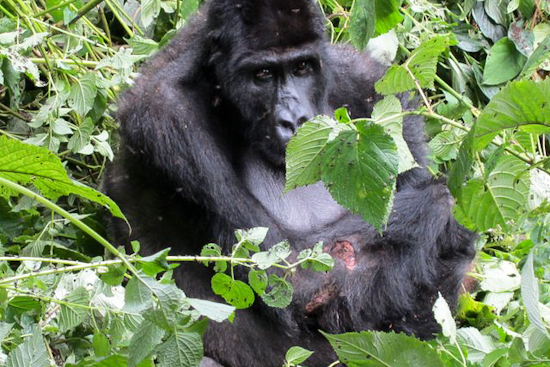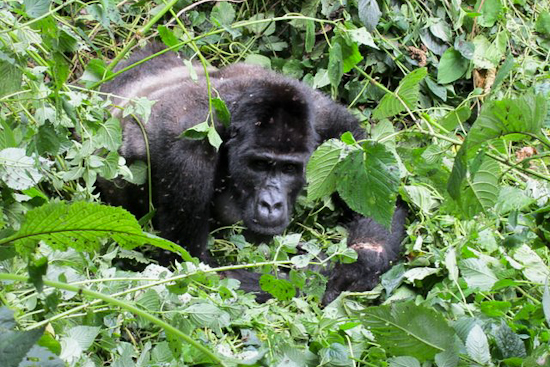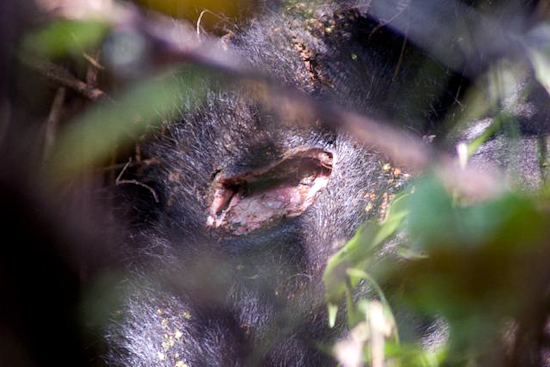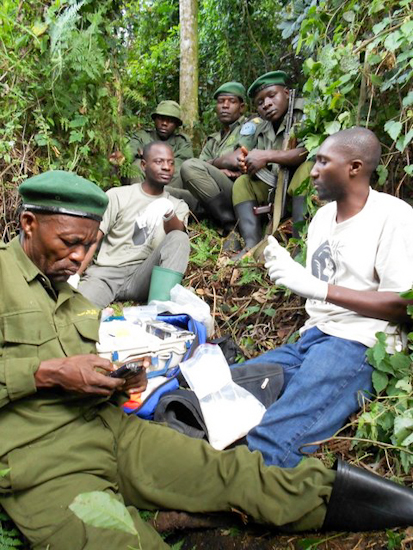Grauer’s Gorilla Silverback Langa Succumbs to Severe Wounds
By Gorilla Doctors Staff on Monday, June 11th, 2012 in Uncategorized.While the Gorilla Doctors have been unable to visit the mountain gorilla groups in Virunga National Park this month due to ongoing fighting between rebel groups and the Congolese army, our field veterinarians Dr. Eddy and Dr. Martin have been able to travel to Kahuzi-Biega National Park in South Kivu to check on the park’s Grauer’s gorillas. This time, their visit coincided with a health scare in Langa group. Dr. Eddy reports:
 Silverback Langa appears gaunt and badly injured.On the morning of June 8, Dr. Martin and I prepared to visit Langa group in Kahuzi-Biega National Park. Trackers informed us that silverback Langa was in poor health after being injured in a fight with Ganywamulume group on May 28.
Silverback Langa appears gaunt and badly injured.On the morning of June 8, Dr. Martin and I prepared to visit Langa group in Kahuzi-Biega National Park. Trackers informed us that silverback Langa was in poor health after being injured in a fight with Ganywamulume group on May 28.
Langa group includes silverback Langa, one adult female, two sub adults, and three juveniles. The silverback lost two adult females and an infant to a lone male in March. The family has been under intensive habituation for the past 10 months and visitors can now approach the group within 7 meters, although Langa still charges frequently.
 Langa walking with a limp.When we arrived at the group we heard Langa screaming and charging. Later he came in to open and began eating with the three juveniles. He appeared very thin with wasted muscles. He is thin partly because of his old age but this has been aggravated by painful-looking wounds, which have clearly reduced his appetite. Langa was moving slowly with a limp in the left leg. He was only using his right arm while walking and feeding.
Langa walking with a limp.When we arrived at the group we heard Langa screaming and charging. Later he came in to open and began eating with the three juveniles. He appeared very thin with wasted muscles. He is thin partly because of his old age but this has been aggravated by painful-looking wounds, which have clearly reduced his appetite. Langa was moving slowly with a limp in the left leg. He was only using his right arm while walking and feeding.
 The deep open wound on Langa’s right arm.Severe, open wounds were visible on both arms, and there was a noticeable bad smell emanating from the gashes. He had a wound that looked about 7 cm long and 3 cm deep halfway up his right arm and he had a smaller wound on his left arm close to the wrist. Despite his wounds, he was alert and responsive, and breathing normally. His appetite was quite good and his stomach looked to be about half full.
The deep open wound on Langa’s right arm.Severe, open wounds were visible on both arms, and there was a noticeable bad smell emanating from the gashes. He had a wound that looked about 7 cm long and 3 cm deep halfway up his right arm and he had a smaller wound on his left arm close to the wrist. Despite his wounds, he was alert and responsive, and breathing normally. His appetite was quite good and his stomach looked to be about half full.
After observing him for some time, we made the plan to return the next morning to dart him with antibiotic and anti-inflammatory drugs. On June 9 we found the group at about 10:15 am. They hadn’t moved far. Unfortunately the place had dense vegetation with branches so it was not easy to find a good spot to shoot the darts. We saw Langa trying to eat with his left hand. He had cleaned both of his wounds and we did not notice the bad smell.
 Drs. Eddy and Martin prepare the darts with the park rangers.We prepared two darts, one with 50mg of the antibiotic Ceftriaxone to help with wound healing and another with 5 mg of the anti-inflammatory Ketoprofen to ease his pain. I was able to successfully dart Langa with the antibiotics, but then he ran into the forest and I was not able to get another good shot. However, the antibiotic was the most important.
Drs. Eddy and Martin prepare the darts with the park rangers.We prepared two darts, one with 50mg of the antibiotic Ceftriaxone to help with wound healing and another with 5 mg of the anti-inflammatory Ketoprofen to ease his pain. I was able to successfully dart Langa with the antibiotics, but then he ran into the forest and I was not able to get another good shot. However, the antibiotic was the most important.
On Monday June 11, Drs. Mike, Jacques, and I returned to Langa group prepared to perform a full intervention after trackers reported that Langa was laying on his stomach and not moving. We found him alive but barely breathing and extremely weak. He appeared to be starving and badly dehydrated. Observing him up close we could appreciate the severity of his wounds as well as view the scars of many older injuries on his body.
Langa was injected with an anesthetic drug so that we could attempt to help him. He was given IV fluids and injections of antibiotic and anti-inflammatory drugs. We then reversed the anesthesia and he slowly recovered, but we were not optimistic about his recovery.
The next morning we returned to find him laying in the same spot where we had left him. It had rained all night and he was probably hypothermic. Maggots were now inside his wounds. The gorillas in the group were nearby and some feces laying next to him indicated that his family members had visited him in the night.
He was nearly dead, but we decided to sedate him so that we could administer pain relievers to make him more comfortable. However, he passed away before we could deliver the injection.
Langa being carried out of the forest.Trackers built a stretcher so we could carry his body out of the forest for a necropsy. The exam revealed how badly he had suffered from his recent and older injuries. His wounds were deeply infected, the left leg was completely deformed, and he was missing his right thumb. Scars from older wounds covered his back, legs, arms, and head. It even appeared that he had a snare wound around his right leg.
It is normal for a silverback to receive multiple injuries during his life but Langa seems to have had a particularly hard time defending his group from rivals. We will now have to see what happens to the remaining six members of the family, which has no silverback or blackback to lead them.
You can follow the Gorilla Doctors health monitoring efforts on our Facebook page, where we post photos and notes from our monthly visits.
Please consider supporting MGVP by making a secure online donation. Every dollar you give goes to directly supporting our gorilla health programs and One Health initiative. Thank you for your generosity.


 Donate
Donate